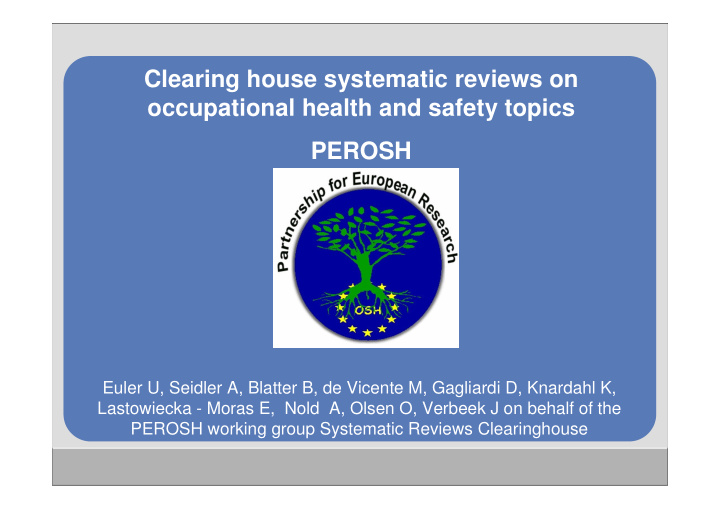



Clearing house systematic reviews on occupational health and safety topics PEROSH Euler U, Seidler A, Blatter B, de Vicente M, Gagliardi D, Knardahl K, Lastowiecka - Moras E, Nold A, Olsen O, Verbeek J on behalf of the PEROSH working group Systematic Reviews Clearinghouse
PEROSH - Members Belgium Czech Republik Denmark Finland France Germany Italy Netherlands Norway Poland Spain United Kingdom 2 Towards Better Work and Well-being, Helsinki 2010
Clearing house systematic reviews • First meeting April 2009 • Project leader: FIOH • Project partners: BAuA, CIOP, IFA, INSHT, ISPESL, NRCWE, STAMI, TNO • Objectives: − Collection of systematic reviews on occupational health topics − Exchange of experiences on any aspect of systematic reviews − A website with all relevant information 3 Towards Better Work and Well-being, Helsinki 2010
Clearing house systematic reviews- methods • Target group: – Professionals – Policy Makers – Researchers • Definition: “ A systematic review attempts to collate all empirical evidence that fits pre-specified eligibility criteria to answer a specific research question. It uses explicit, systematic methods that are selected with a view to minimizing bias, thus providing reliable findings from which conclusions can be drawn and decisions made.” according to P referred R eporting I tems for S ystematic Reviews and M eta- A nalyses: The PRISMA Statement (http://www.prisma-statement.org/) 4 Towards Better Work and Well-being, Helsinki 2010
Clearing house systematic reviews - methods • Inclusion criteria: – A clearly defined question with reference to Participants, Interventions or exposure, Comparisons, Outcomes, and Study design (PICOS) Question on the following aspects of occupational diseases and injuries are included and categorized: → Intervention: therapy and prevention → Prognosis → Diagnosis → Etiology → Prevalence/incidence – Inclusion of an electronic search of at least one database – Publication date 2000 to present (unless the type of exposure warrants older reviews) 5 Towards Better Work and Well-being, Helsinki 2010
Clearing house systematic reviews - methods • Inclusion Criteria for Occupational Health and Safety topics: – Occupational exposure e.g. - Chemical exposures - Stress at work - Biomechanical loading – Occupational outcomes e.g. - Occupational diseases or symptoms - Workability/disability and productivity loss - Injuries 6 Towards Better Work and Well-being, Helsinki 2010
Clearing house systematic reviews - methods • Classification according to PICO: – Participants: workers – Intervention / Exposure: welding fumes – Comparison: no exposure to welding fumes – Outcome: lung cancer • Search strategy: – Databases: at least PubMed and Embase – A joint literature search strategy: → terms for the disease → terms for the occupation or exposure → terms for the type of study 7 Towards Better Work and Well-being, Helsinki 2010
Clearing house systematic reviews - first results Examples: • Do factors at work lead to neck and work related upper limb disorders ? • Does physical work load lead to hip osteoarthritis? • Workplace interventions for preventing needle stick injuries in health care personnel • Systematic Reviews of work-related economic outcomes • Is aggression more frequent in health care workers compared to other workers in public functions? • Interventions to prevent noise-induced hearing loss • Prognostic factors for the duration of sickness absence in musculoskeletal disorders • Does solar UV radiation lead to skin diseases in outdoor workers? 8 Towards Better Work and Well-being, Helsinki 2010
Clearing house systematic reviews – under construction and discussion • Website including – a searchable database with review abstracts – information on the methods/ criteria used for searching and selecting reviews • Quality assessment and critical appraisal of systematic reviews 9 Ulrike Euler Towards Better Work and Well-being, Helsinki 2010
Recommend
More recommend